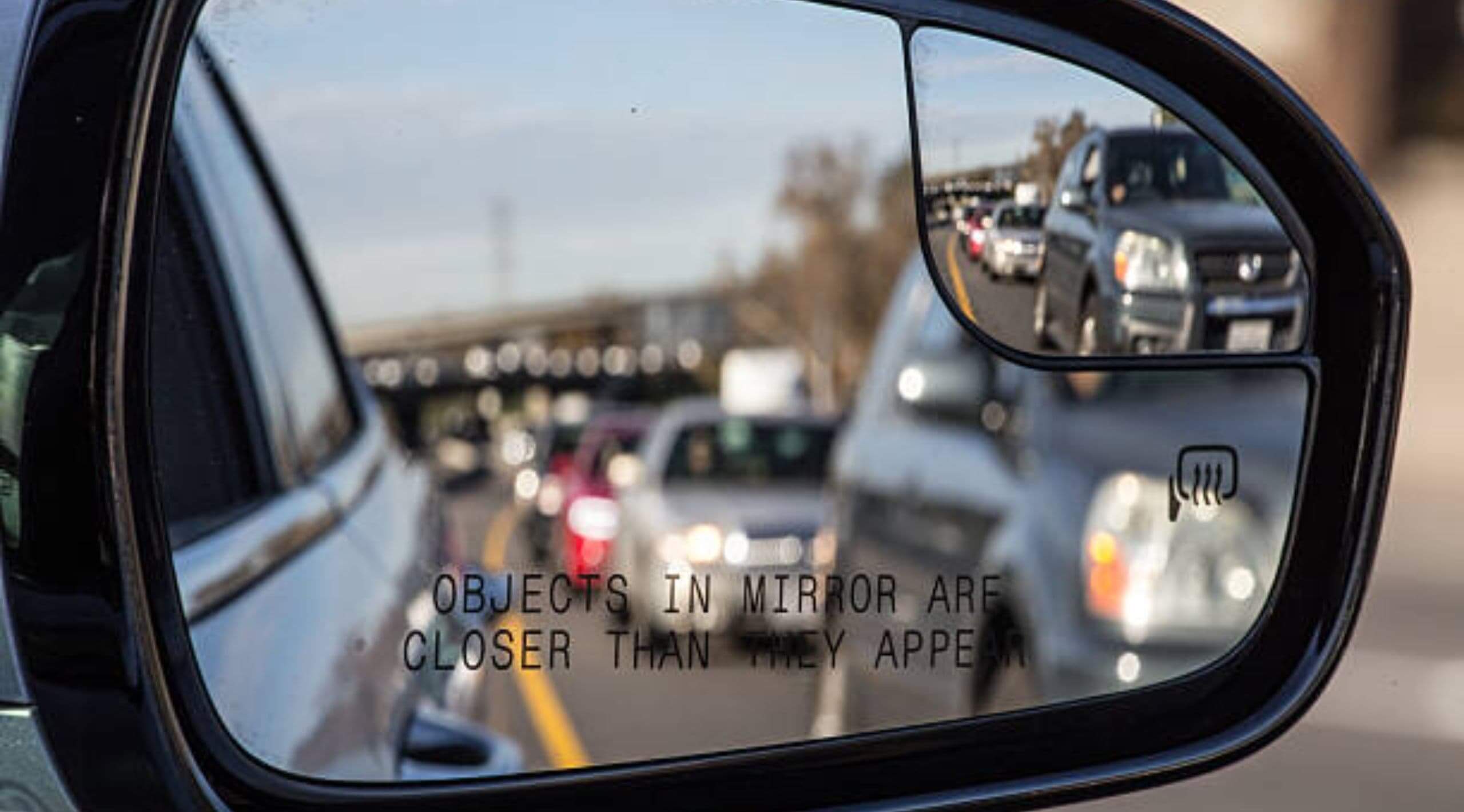Understanding Convex Mirrors and Distance Perception
Convex mirrors, predominantly seen on the passenger side of vehicles, are a staple in modern automotive design. Their unique curvature provides a wider field of view, which is especially beneficial in reducing the notorious blind spot. This design choice, however, isn’t without its drawbacks. The very feature that allows for a broader view also causes objects to appear more distant than they truly are. This optical characteristic of convex mirrors is rooted in the science of optics. The safety warning “objects in mirror are closer than they appear” isn’t just a casual reminder but a crucial alert. It’s noteworthy that this phrase isn’t exclusive to one region; it’s a globally recognized caution, with countries ranging from the United States to India and Canada incorporating it into their vehicle safety standards. This universal adoption underscores the importance of understanding and respecting the nuances of mirror optics for road safety.
The Science Behind Objects Appearing Closer in Mirrors
Diving deeper into the realm of optics, one can better grasp why convex mirrors, particularly those on the side of vehicles, distort distance perception. When light reflects off an object and hits the curved surface of a convex mirror, it diverges. This divergence causes the reflected objects to appear smaller, leading to the illusion that they are further away. In stark contrast, flat mirrors reflect light in a manner that retains the object’s relative size and distance, offering a more “true-to-life” reflection. The ubiquitous warning “objects in mirror are closer than they appear” isn’t just a random phrase; it’s a scientifically-backed statement aimed at compensating for this inherent optical illusion. By understanding the science behind this, drivers can be more vigilant and make informed decisions on the road.
Safety Trade-off: Enhanced Visibility vs. Distance Illusion
Safety is paramount when it comes to vehicle design, and mirrors play a pivotal role in this. Convex mirrors, with their ability to offer an expansive field of view, are a testament to this commitment to safety. They significantly reduce the blind spot, especially on the passenger side, providing drivers with a more comprehensive view of their surroundings. However, every design choice comes with its set of trade-offs. In the case of convex mirrors, while they excel in offering a panoramic view, they inadvertently distort the actual distance of objects. This distortion can lead to misjudgments on the road if not understood correctly. Hence, the safety warning “objects in mirror are closer than they appear” is not just a mere statement but a vital cue. It serves as a constant reminder for drivers to be wary of the distance illusion and underscores the importance of always being alert and cautious while driving.
Impact of Mirror Design on Perception Accuracy
The design and type of mirrors used in vehicles have a profound impact on how drivers perceive their surroundings. In regions like North America, South Korea, and Nepal, the emphasis on safety has led to specific design choices in mirrors. For instance, the United States predominantly uses flat mirrors on the driver’s side, ensuring that drivers get an accurate reflection of vehicles and objects behind them. This design choice minimizes the risk of misjudgment due to distance distortion. On the other hand, the passenger side often features a convex mirror, which, while offering a wider field of view, can distort the perceived distance of objects. This balance between a comprehensive view and accurate distance perception is crucial in ensuring safety on the roads. As automotive technology and design continue to evolve, understanding the implications of these choices becomes paramount for both manufacturers and drivers.
Why Side Mirror Warnings for Safe Driving Matter?
The phrase “objects in mirror are closer than they appear” is more than just a standard disclaimer. It’s a critical safety warning that underscores the potential risks associated with misjudging distances in convex mirrors. The distortion these mirrors introduce can lead drivers to believe that vehicles or obstacles are farther away than they truly are, potentially leading to hazardous situations, especially when changing lanes or merging. Recognizing the gravity of this potential risk, many countries, spanning from Canada to India, have made it mandatory to include this warning on passenger side mirrors. This global mandate highlights the universal importance of ensuring drivers are constantly reminded of the nuances of mirror optics and the need to exercise caution.
Adapting to Distorted Reflections in Convex Mirrors
For rookie drivers, the initial experience with convex mirrors can be disorienting. The distorted reflections these mirrors produce can be challenging to interpret, especially when making split-second decisions on busy roads. However, as with many aspects of driving, experience plays a significant role in adapting to these distortions. Over time, seasoned drivers develop an innate ability to compensate for the discrepancies introduced by convex mirrors. This intuitive understanding allows them to gauge the actual distance of vehicles and objects more accurately, leading to safer driving practices. Continuous awareness and practice are key to mastering the art of interpreting reflections in convex mirrors, ensuring that drivers can navigate roads with confidence and safety.
Tips for Navigating Roads with Mirror Distance Discrepancy
Driving safely requires a comprehensive understanding of the vehicle’s features and their implications on the road. One of the most critical aspects is the mirror system, especially given the distance discrepancies in convex mirrors. Here are some essential tips to ensure safety:
- Manual Blind Spot Checks: Relying solely on mirrors can sometimes be misleading. Always make it a habit to double-check blind spots manually before changing lanes. This extra step can prevent potential collisions.
- Internalize the Warning: The phrase “objects in mirror are closer than they appear” isn’t just a casual reminder. By keeping this keyword at the forefront of your mind, you’ll be more conscious of the inherent distortions of convex mirrors and adjust your driving decisions accordingly.
- Mirror Adjustments: Proper positioning of mirrors is crucial. Ensure they are adjusted to capture the maximum field of view. This not only helps in covering more area but also minimizes the blind spots.
- Approach with Caution: Even if a vehicle or obstacle in the convex mirror seems to be at a safe distance, always approach or react with caution. Given the mirror’s design, that vehicle or object might be much closer than it appears.
By incorporating these tips into your driving routine, you can navigate roads more safely and confidently, ensuring a safer journey for yourself and others on the road.
Decoding the Illusion: Objects in Mirror Closer Than They Appear
Convex mirrors, by design, create an optical illusion that can be both beneficial and misleading. The primary reason behind the question, “why are side mirrors convex?” is the necessity for a wider field of view, especially in bustling traffic scenarios. This broader perspective, however, comes at the cost of accurate distance perception. Objects reflected in these mirrors often seem more distant than they truly are. Decoding this illusion is paramount for drivers, as understanding this discrepancy can be the difference between safe driving and potential road hazards.
Conclusion: Demystifying the Distance Illusion in Mirrors
The adage “objects in mirror are closer than they appear” is more than just a cautionary phrase; it’s a fundamental principle for road safety. Convex mirrors, while providing an expansive view, introduce a distance illusion that every driver must be aware of. By understanding the underlying science and being vigilant of this distortion, drivers can make informed decisions on the road. As we conclude, it’s imperative to remember that while technology and design can aid us, awareness and understanding remain the cornerstones of safe driving.

